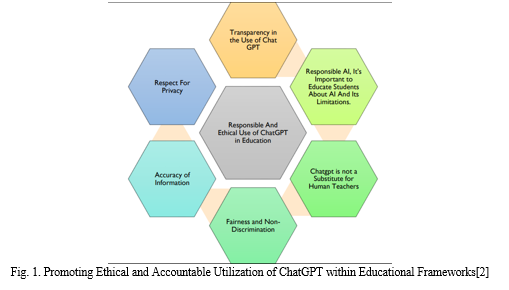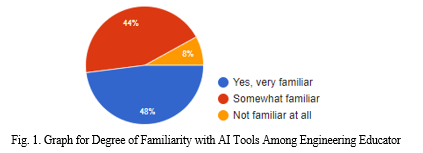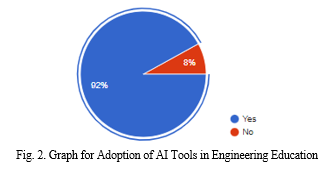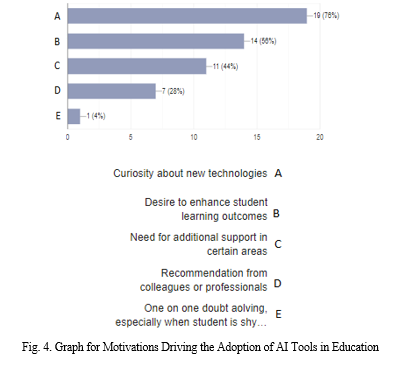Ijraset Journal For Research in Applied Science and Engineering Technology
- Home / Ijraset
- On This Page
- Abstract
- Introduction
- Conclusion
- References
- Copyright
Exploring the Impact of Artificial Intelligence Tools in Engineering Pedagogy: A Qualitative Survey of Academic Experiences
Authors: Harsh R. Mishra, Mital D. Sarvaiya
DOI Link: https://doi.org/10.22214/ijraset.2024.57864
Certificate: View Certificate
Abstract
Artificial Intelligence (AI) is revolutionizing the landscape of Engineering Education, albeit with limited empirical qualitative assessment of its potential and perceived benefits or challenges. This paper investigates the integration and experiences of academic professionals with AI tools in their pedagogical practices. The study employs a comprehensive survey asking specific questions relating to the familiarity, motivation, usage, training, benefits, challenges, ethical considerations, and future implications of AI tools like ChatGPT, Google Bard, and Microsoft Bing. The results illustrate a broad understanding and adoption of AI tools, and their instrumental role in enhancing educational methods and pedagogical approaches. However, the findings also highlight the need for adequate training and ethical guidelines for responsible AI use. Additionally, perceived challenges are revealed, underscoring the importance of addressing them to harness AI\'s full potential in education. Overall, this research contributes to the understanding of AI\'s value in education from an academic standpoint, outlining its role, advantages, challenges, and future expectations. This study is essential in the ongoing discourse of AI in education, and it can inform the development of training, policies, and strategies for effective and responsible AI integration in the future of engineering education.
Introduction
I. INTRODUCTION
The advent of Artificial Intelligence (AI) is reshaping the panorama of numerous fields, notably education. In the context of engineering education, AI tools, including chat-based AI tools such as ChatGPT, Google Bard, and Microsoft Bing, offer unprecedented opportunities for enhancing teaching and learning processes.
These technologies provide platforms for collaborative learning, personalized feedback, and sophisticated data analysis, thereby potentially revolutionizing pedagogical practices. Despite their widespread use and acknowledged potential, comprehensive qualitative assessments exploring the practical experiences, perceived benefits, and challenges of academic professionals utilizing these AI tools remain scant. Traditional methods for developing product and engineering designs rely heavily on human knowledge, applying a combination of scientific principles, instinctual reasoning, hands-on experience, and innovative techniques[1].
Understanding the realities of integrating AI tools in educational practices is critical to maximize their potential, address challenges, and shape future educational policies and strategies. Moreover, considerations about the ethical use of AI in education underline the importance of a comprehensive examination of the phenomenon.
This paper aims to contribute to this ongoing discourse by investigating the experiences and perceptions of academic professionals concerning the application of AI tools in engineering education. Specifically, this research will probe the following aspects: familiarity with AI tools, motivations behind their usage, tasks performed using these tools, available training or support, perceived benefits, encountered challenges, ethical use, and the anticipated role of AI tools in the future of education.
Through this endeavor, the paper seeks to outline an informed perspective on AI's role in engineering education, offering valuable insights for educators, researchers, and policymakers.
A. Promoting Ethical and Accountable Utilization of ChatGPT within Educational Frameworks[2]
In order to secure a beneficial, equitable, and respectful engagement for learners, educators, and all other concerned parties, it is crucial to follow ethical and accountable procedures when employing this technology within educational contexts.
The deployment of AI tools in education, like ChatGPT, has the potential to provide significant advantages. However, it also brings forth issues related to ethics and accountability[2].

The commitments and ethical applications of ChatGPT within the educational domain are encapsulated in the image referred to as figure 1 provided above. These commitments encompass maintaining privacy, ensuring fairness and avoiding discrimination, maintaining transparency in the application of ChatGPT, among others[2].
II. METHODOLOGY
A. AI Tools in Education
ChatGPT is an advanced AI language model developed by OpenAI. It leverages machine learning techniques to generate human-like text based on the input it receives. In the context of education, it can be used to create engaging, interactive learning experiences. For instance, it can answer questions, assist in generating content, provide explanations, and facilitate personalized learning experiences by adjusting its responses to the learner's knowledge level and queries.
Google Bard is another AI tool used in the educational field. It is designed by Google's AI team to create nuanced, creative text. While similar to ChatGPT in generating human-like text, Bard aims to showcase creativity and comprehensive language understanding, making it a potentially useful tool for promoting creativity and out-of-the-box thinking in engineering education.
Microsoft Bing, while known as a web search engine, also includes a robust conversational AI component. This conversational AI can provide instant responses to queries, help with content generation, and support interactive learning. Bing's AI has been utilized in various educational settings, aiding in tasks such as research, collaborative work, and exploration of complex topics.
B. Research Design
The study followed a qualitative research design to gather nuanced insights into the experiences of academics with these AI tools. The primary data collection instrument was an online survey, aimed at exploring the participants' perspectives.
C. Participant Selection
The survey targeted a academic professionals involved in engineering education across various educational institutions. Participants were selected based on their experience in using AI tools in their pedagogical practices.
D. Data Collection
Data was collected through an online survey comprising questions on various aspects of AI tools usage in education. The survey asked questions about familiarity with AI tools, specific tasks performed, available training or support, perceived benefits, challenges, ethical considerations, and the future role of AI tools in education.
III. SURVEY-DERIVED FINDINGS & RESULTS
This section presents the findings and results gathered from the survey conducted among academic professionals in the field of engineering education. It provides a comprehensive exploration of the participants' experiences, perceptions, and insights regarding the use of AI tools, namely ChatGPT, Google Bard, and Microsoft Bing, in their pedagogical practices. These results are instrumental in deciphering the realities, benefits, challenges, and potential future of AI integration in the educational landscape. Let's delve into the detailed findings that emerged from the responses to our survey.
A. Familiarity with AI Tools and Their Applications in Education
The surveyed academic professionals showcased varying degrees of familiarity with AI tools and their applications in the field of education. Nearly half of the respondents, constituting 48%, indicated they were “Very familiar”with AI tools, suggesting a considerable engagement with and understanding of AI applications within their educational practice. This degree of familiarity likely reflects an active use of AI tools in engineering education and contributes to an informed perspective on their benefits, challenges, and potential future.

Meanwhile, 44% of the participants reported being “Somewhat familiar” with AI tools, indicating they had a basic understanding or had perhaps limited experience with these tools in their pedagogical activities. This segment of respondents illustrates a significant potential for further exploration and integration of AI tools in their practices.
A small percentage of participants, 8%, reported they were “Not familiar at all” with AI tools in education, suggesting they had minimal to no experience or exposure to these technologies. This portion of respondents underscores the necessity for initiatives aimed at increasing AI awareness and training in the academic community to ensure comprehensive adoption and optimal utilization of AI tools in engineering education.
B. Usage of AI Tools in Professional Practice
The survey revealed a high level of engagement with AI tools among academic professionals. A substantial 92% of the respondents confirmed their usage of AI tools, specifically chat-based ones such as ChatGPT, Google Bard, and Microsoft Bing, to support their professional tasks in engineering education. Conversely, a minority of 8% expressed unfamiliarity with these tools. This data indicates a prevalent trend of AI adoption in pedagogical practices, while also underscoring the existence of a segment that remains unacquainted with these transformative tools.

C. Application of AI Tools in Diverse Educational Tasks: Experiences from the Field
The survey respondents provided a wealth of insights about their experiences using AI tools for various educational tasks and activities. One of the primary applications was personalized student support and tutoring. AI tools allowed educators to tailor their teaching approaches and materials to individual student needs, thereby fostering a more inclusive learning environment. Furthermore, the tools showed efficacy in supporting students with special needs, offering personalized engagement that encouraged their learning progression.
The respondents also reported using AI tools to generate lesson plans and educational content. The ability of these tools to analyze extensive data and generate comprehensible content significantly reduced the time and effort required for lesson preparation. This not only streamlined the process but also enriched the learning material, enhancing its overall quality and effectiveness.
AI tools were used to enhance student engagement and interaction. With their conversational capabilities, these tools facilitated dynamic and interactive learning experiences. They were particularly beneficial in concept reinforcement and problem-solving, where they provided instant feedback and guidance to students.
In terms of research and information gathering, AI tools played a pivotal role. They assisted in organizing research, identifying relevant resources, and providing citation assistance. This proved advantageous in fostering a research-oriented approach among students.
Lastly, respondents reported that AI tools assisted with administrative tasks such as scheduling or organization. This functionality proved valuable in managing teaching loads, organizing curricula, and keeping track of student progress, ultimately leading to improved overall efficiency and productivity.
D. Motivations for Incorporating AI Tools in Educating Practice
The motivation to incorporate AI tools in educational practices stems from a diverse range of factors, as indicated by the survey responses from academic professionals. The participants were asked about the reasons that prompted them to try using AI tools in their educating practice. The results reveal intriguing insights into the motivations driving the adoption of these tools.
Curiosity about new technologies emerged as the primary motivation, with a substantial 76% of respondents expressing their interest in exploring and leveraging the potential of AI tools. This curiosity reflects a proactive approach among educators to stay abreast of advancements in technology and harness its innovative capabilities to enhance their teaching practices.

For 56% of the participants, the desire to enhance student learning outcomes was a compelling motivator. These educators recognized the potential of AI tools to provide personalized and adaptive learning experiences, enabling them to address individual student needs, promote engagement, and facilitate a deeper understanding of complex engineering concepts.
Additionally, 44% of respondents cited the need for additional support in certain areas as a motivating factor for incorporating AI tools. Recognizing that AI tools can assist in automating repetitive tasks, providing instant feedback, and analyzing large datasets, these educators sought technological support to streamline their teaching workflows and improve efficiency.
A smaller percentage of respondents (7%) reported that recommendations from colleagues or professionals played a role in motivating their exploration of AI tools. This suggests the influence of social networks and the importance of sharing knowledge and experiences within the academic community.
Overall, these survey findings highlight the multi-faceted motivations driving the adoption of AI tools in educating practice. Whether fueled by curiosity, a desire for enhanced student learning outcomes, the need for additional support, or recommendations from peers, these motivations collectively contribute to the evolving landscape of engineering education and pave the way for innovative teaching methodologies. In the context of the research, a dataset consisting of two authentic human images has been used. These images were captured by a camera and represent two different individuals, who have been assigned the aliases "Person A" and "Person B". The use of pseudonyms is a common practice in research to maintain confidentiality and privacy of the subjects. These images will be utilized to train and test the face recognition system developed in this study.
E. Training and Support for Effective Use of AI Tools
This section asked participants whether they received any training or support on how to effectively use AI tools in their work. The responses revealed that among the participants, 4% indicated they had received extensive training, 24% reported having received basic training, while the majority, 72%, stated that they learned to use AI tools on their own.

Additionally, 52% of respondents stated that they regularly monitor and evaluate the AI tool's output. This highlights a proactive approach in assessing the generated content or responses to ensure they align with ethical standards and educational objectives. By actively monitoring and evaluating the AI tool's output, educators can identify and address any potential biases, inaccuracies, or inappropriate content that may arise.
Furthermore, 32% of participants reported incorporating discussions about ethical considerations with their students. This approach emphasizes the importance of fostering an ethical mindset and critical thinking among students regarding the use of AI tools. Engaging in ethical discussions encourages students to reflect on the potential implications, limitations, and responsible use of AI tools in their learning journey.
Following the section on "Ensuring Ethical and Responsible Use of AI Tools in Learning Practice," we delve deeper into the underlying principles that govern ethical AI use. In Table 1, titled "Summary of Core Ethical Principles for AI" we present a comprehensive breakdown of these principles, each offering critical insights into various aspects of AI deployment from accountability to sustainability. This table serves as a guide to promote ethically conscious practices in AI implementation, which is paramount in any learning environment.
Table. 1: Summary of Core Ethical Principles for AI[3]
|
Sr. no |
Core Ethical Principles for AI |
Definition |
|
1 |
Obligation |
Enforces the liability of AI actors for AI systems' operations and ethical adherence |
|
2 |
Precision |
Acknowledges and relays the sources of discrepancies and unpredictability in algorithms and data to guide remedial steps |
|
3 |
Scrutinability |
Provides for third-party assessments of algorithmic actions via clear information sharing |
|
4 |
Comprehensibility |
Guarantees that data and algorithm-driven decisions can be translated into simple language |
|
5 |
Equitability |
Counteracts biased outcomes, employs monitoring systems, and seeks diverse viewpoints in system creation |
|
6 |
Human Focus and Welfare |
Elevates human needs and health as the prime concern in the design and application of AI |
|
7 |
Alignment with Human Rights |
Verifies that technologies do not infringe upon globally accepted human rights |
|
8 |
Universality |
Ensures AI is made available to all |
|
9 |
Forward-thinking |
Prefers initiatives that offer considerably more benefits compared to their counterparts |
|
10 |
Answerability, Responsibility, and Openness |
Nurtures trust via responsibility, accountability, and fairness, offers means for recourse, and preserves records of design workflows |
|
11 |
Strength and Safety |
Ensures AI systems are secure, impenetrable, and immune to unauthorized access or data breach |
|
12 |
Endurance |
Prefers methods that deliver long-term, advantageous findings and can anticipate future trends |
G. Impact of AI Tools on Pedagogical Approaches: An Overview
In a recent survey, a significant majority, 80% of the respondents, reported noticeable transformations in their teaching methods and pedagogical strategies due to the integration of artificial intelligence (AI) tools. They affirmed that the use of AI in education has introduced innovative teaching techniques, enabling more personalized, efficient, and engaging learning experiences. On the other hand, 20% of the respondents noted no significant change in their educational methods, maintaining traditional teaching techniques despite the influx of AI tools. These findings highlight the rising influence of AI in shaping modern educational practices, while also underlining the fact that a portion of educators remain unaffected by this technological shift.
IV. FUTURE WORK
This research paper provides valuable insights into the experiences, perspectives, and practices of academic professionals regarding the use of AI tools in engineering education. Building on the findings and results presented, there are several areas that warrant further exploration and future work:
- Longitudinal Studies: Conducting longitudinal studies to track the long-term impact of AI tool integration in engineering education would provide a deeper understanding of the sustained benefits, challenges, and changes observed over time.
- Comparative Analysis: Conducting comparative analysis between different AI tools and their effectiveness in engineering education can help identify the strengths and weaknesses of each tool, enabling educators to make informed decisions when selecting and utilizing AI tools.
- Student Perspectives: Incorporating student perspectives through interviews or focus groups would provide insights into their experiences, perceptions, and expectations regarding AI tool integration in engineering education. This would enrich the understanding of the student's role in the learning process and their interaction with AI tools.
- Ethical Guidelines and Frameworks: Developing and refining ethical guidelines and frameworks specifically tailored to the integration of AI tools in engineering education would provide educators with a solid foundation for ensuring responsible and ethical use of these tools.
- Teacher Training and Professional Development: Designing and implementing training programs and professional development opportunities for educators to enhance their understanding and competence in utilizing AI tools effectively and ethically would further promote their successful integration in engineering education.
- Impact on Learning Outcomes: Investigating the impact of AI tool integration on learning outcomes, student engagement, and retention rates in engineering education would provide empirical evidence of the effectiveness and value-added by these tools.
By addressing these avenues for future work, researchers and educators can continue to advance the understanding and application of AI tools in engineering education, fostering a more informed, responsible, and effective educational landscape.
Conclusion
This research paper offers meaningful perspectives on the views, experiences, and practices of educators in the use of AI resources, including but not limited to ChatGPT, Google Bard, and Microsoft Bing, within the realm of engineering education. The research emphasizes the potential advantages, obstacles, and ethical factors tied to the implementation of these AI tools in teaching methodologies. Survey data revealed that educators have a good understanding of AI tools and acknowledge their capacity to enrich pedagogical methods. They apply these tools in a range of applications such as content creation, tailored feedback, and fostering cooperative learning. The perceived merits include heightened efficiency, increased student engagement, and diversified learning prospects. Despite these benefits, the study also unveiled challenges, encompassing the requirement for comprehensive training, worries about AI-induced biases, and ethical dilemmas linked to the use of AI resources. Addressing these issues is crucial for the principled and ethical adoption of AI in engineering education. This calls for adhering to existing protocols or policies, routinely assessing the AI\'s performance, and initiating ethical dialogues with students. The outcomes of this study add to the evolving conversation on the role of AI in education. They underscore the need for training and backing educators in effectively deploying AI tools, while also stressing the importance of ethical cognizance and conscientious implementation. It is advised that education bodies and policymakers devise thorough policies and plans to facilitate ethical and responsible use of AI tools in the field of engineering education. In summary, while AI resources offer tremendous potential in redefining engineering education, their successful adoption necessitates ethical considerations, overcoming hurdles, and ensuring suitable support. With a responsible approach towards AI tools, educators can enhance teaching methods, stimulate student involvement, and positively influence the trajectory of engineering education.
References
[1] Khaleel, M., Ahmed, A. A., & Alsharif, A. (2023). Artificial intelligence in engineering. Brilliance, 3(1), 32–42. https://doi.org/10.47709/brilliance.v3i1.2170 [2] Mhlanga, D. (2023). Open AI in Education, The responsible and ethical use of ChaTGPT towards lifelong Learning. Social Science Research Network. https://doi.org/10.2139/ssrn.4354422 [3] Chan, C. K. Y. (2023). A comprehensive AI policy education framework for university teaching and learning. International Journal of Educational Technology in Higher Education, 20(1). https://doi.org/10.1186/s41239-023-00408-3
Copyright
Copyright © 2024 Harsh R. Mishra, Mital D. Sarvaiya. This is an open access article distributed under the Creative Commons Attribution License, which permits unrestricted use, distribution, and reproduction in any medium, provided the original work is properly cited.

Download Paper
Paper Id : IJRASET57864
Publish Date : 2024-01-02
ISSN : 2321-9653
Publisher Name : IJRASET
DOI Link : Click Here
 Submit Paper Online
Submit Paper Online

